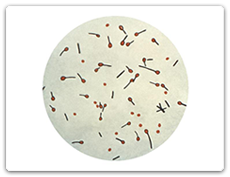Tetanus (Clostridium tetani)
 Tetanus is a disease caused by a toxin released by the bacterium Clostridium tetani. It is commonly referred to as “lockjaw”. The word “lockjaw” comes from the familiar symptom associated with tetanus – stiffness of the neck and jaw. Tetanus spores can live in dirt, dust and manure. They can get into the body through a cut, puncture wound or burn and cause infection. If people become infected with tetanus, they can have very serious illness.
Tetanus is a disease caused by a toxin released by the bacterium Clostridium tetani. It is commonly referred to as “lockjaw”. The word “lockjaw” comes from the familiar symptom associated with tetanus – stiffness of the neck and jaw. Tetanus spores can live in dirt, dust and manure. They can get into the body through a cut, puncture wound or burn and cause infection. If people become infected with tetanus, they can have very serious illness.
Image Content Provider: CDC Public Health Image Library
Symptoms
Tetanus symptoms appear slowly and get worse over time. Symptoms take three days to three weeks to develop. They can include stiffness in the jaw and neck and difficulty swallowing. The stiffness then spreads to the arms, legs and stomach. There may be painful spasms to the point where bones break. If tetanus affects muscles that help people breathe, there may be severe breathing problems.
Causes
Tetanus is caused by a toxin released by the bacterium Clostridium tetani. Infection occurs when tetanus spores that contaminate dirt, dust and manure enter the body through a puncture wound, cut or burn. The germ can also enter the body through an unclean injection.
Since the germ does not require oxygen to survive, the presence of dead tissues is the most favourable condition for their growth and toxicity.
Treatment
Treatment requires hospitalization so medicines and fluids to control the muscle spasms and pain may be given. The wound or cut also needs to be cleaned to remove any germ and to stop them from making toxin. Tetanus immunoglobulin (TIG) may be used to help your body's immune system find and destroy the germ.
Prevention
Tetanus can be prevented through immunization. Manitoba has a provincial immunization program, which provides free, publicly-funded vaccines to those who are eligible.
A booster shot should be taken every 10 years after the first series of immunizations. See your health care provider as soon as possible if you have a wound or cut and more than five years have passed since your last tetanus shot. Some people may require TIG for a wound that has a high risk of tetanus infection.
Manitoba Health Resources
For the Public
- Grades 8/9 School Immunization Program – Factsheet for Parents & Guardians

(April 2018) - Tetanus and Diphtheria (Td) Vaccine

(October 2010) - Tetanus, Diphtheria and acellular Pertussis (Tdap) Vaccine

(July 2012)
For Health Care Providers
- Tetanus protocol

(November 2001 with December 2012 update) - Immunization Program Manual for Immunization Providers in Manitoba
- Manitoba's School Immunization Program – Questions & Answers for Health Care Providers

(May 2018)
Other Resources
- HealthLinkBC – Tetanus Topic Overview
- Public Health Agency of Canada – What you need to know about tetanus (lockjaw)
Communicable Disease
Control (CDC) Health Links – Info Santé |


